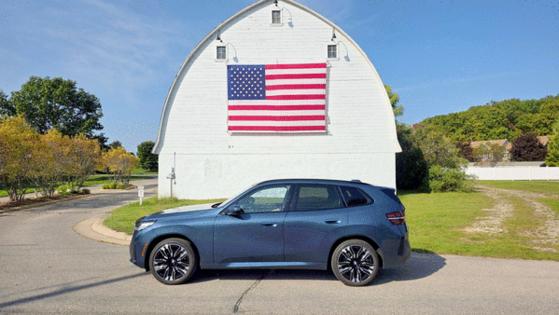Auto review: Road trippin' in the big, bold, boosted BMW X3
Published in Business News
GAYLORD, Michigan — I made an easy drive this fall up Interstate 75 to Charlevoix. Cruising on adaptive cruise control at 80 mph, listening to Sirius XM. Navigating Google Maps on a jumbotron screen while taking in the fall colors. I could have been in any compact SUV.
But as I exited at Gaylord onto the challenging M-32 twisties, I selected the SPORT head-up display with digital racing tachometer, toggled the automatic shifter to manual SPORT mode, and engaged the shift/BOOST paddles sprouting from the steering wheel.
GRRRRRR! went the 255 ponies in front of me. Achtung! I’m in a BMW X3, all right.
I spent the next 25 miles conquering S-turns, long downhill sweepers and short straightaways while red-lining the eight-speed transmission. It was a welcome pick-me-up on a long road trip — and a welcome departure from the average SUV.
In truth, the average SUV is very, very, very good these days.
Since BMW unveiled its xActivity concept — the near-production peek at the first-gen, 2004 X3 — at the 2003 Detroit Auto Show (back when the Detroit show scored major BMW reveals), autodom has changed and compact utes have become the largest non-pickup segment in the U.S. market. Every major automaker from Acura to VW sells in the segment. Made in America, the X3 is BMW’s best-selling U.S. model.
This competitive shark tank has created an impressively high standard for entry. Combine that with the electronics revolution, and the compact segment has democratized with little practical difference between mainstream and luxe offerings.
My $52K BMW X3’s dual digital screen? The $30K Hyundai Tucson offers a similar unit. The X3’s standard all-wheel-drive system? Same for the $31K Subaru Forester. The sporty, automatic chiclet shifter? The $32K VW Tiguan’s got it. BMW’s 255-horse turbo-4 engine? Yeah, yeah — check out the $42K Mazda CX-50 Turbo’s 256-horsepower unit.
So to separate itself from the pack, X3 has leaned into BMW’s heritage of design and performance.
Start with that big, bold kisser.
Current BMW design is bold and chunky — a throwback to the brand’s 1940s-era vertical grilles. It’s problematic on cars like the BMW 3-series sedan, but on more upright SUVs like X3, it fits. The twin-kidney grille is further distinguished by a striking, signature cross-hatch pattern. Love it.
That pattern is repeated inside: cross hatch on the console charger cubby, air vents, console volume knob — even the small steering wheel selector button. It’s detail that sets X3 apart in a modern, screen-focused interior.
The screens themselves are flush with visual detail, from lush instrument display graphics to the sand-dune background on the infotainment screen to the layers of digital options (want the X3 to unlock/lock automatically as you approach/walk away? There’s a setting for that). They were a welcome companion on the long interstate drive.
Another notable detail: BMW has — like mainstream automakers — deferred navigation to Google Maps. The cloud-based Google ecosystem includes apps we commonly use on our phones. Standard (as with other brands) is a wireless charging pad so your phone doesn’t run out of juice while navigating your route).
I navigated my northern trip while listening to Sirus XM. BMW fully integrates those apps to show turn-by-turn directions in the head-up display and station listings in the instrument cluster.
All this tech is housed in a chunky interior design — accented with ambient lighting — as distinctive as the exterior. Check out the meaty door controls and console. More clever detail? Door inserts that hold tall drink bottles.
One detail I could do without is the big rotary infotainment screen controller. Bimmer pioneered this feature in the early 2000s as a symbol of luxury — since copied by aspirational brands like Mazda and Genesis seeking to show their good taste. But the feature has become an anomaly in the touchscreen age, with even Mazda reportedly abandoning it for its next-gen vehicles.
BMW long ago made the rotary controller redundant, and I navigated the instrument screen by touch. Mostly. I have to admit the rotary dial is handy when driving, so I didn’t have to take my eyes off the road when reaching for the screen to, say, change the channel in Sirius XM. But for most folks who rode with me, the controller just takes up valuable console real estate.
Much of the X3’s design theme was first seen on the iX electric SUV, which, in turn, had adopted Tesla-inspired digital tech that has transformed vehicle interiors over the past 10 years. But X3 does this while also offering the inherent advantages of gas power.
While stomping all over northern Michigan with my right lead foot, I never worried about range anxiety from the 2.0-liter turbo-4 engine. With a 17.2-gallon gas tank, the X3 sported an impressive 568 miles of range that could get me to Charlevoix and back to Metro Detroit without visiting a gas station.
By contrast, the pricier, all-wheel-drive electric i4 compact sedan (an electric version of the X3 is not due until next year) gets just 227 miles of range and would likely require at least three lengthy charging stops on a round-trip Charlevoix journey.
The Bimmer emphasizes cargo room (large for the class) over rear-seat legroom (small for the class). I was able to stuff the trunk with all my gear for a weekend trip, while also comfortably fitting a foursome for an evening trip to Charlevoix Pickleball courts.
The foursome had varying views on the Bimmer’s styling (“nice,” “too chunky,” “Porsche Macan is sleeker”), while my friend Jon enjoyed sticking the tranny in SPORT mode and playing with the head-up display’s tachometer. Boys will be boys.
Speaking of Porsche, on the trip back south I played with the BOOST paddle. Porsche popularized this “Push to Pass” feature in its sports cars, and it quickly spread among other performance brands.
BOOST instantly shifts the transmission into the optimal torque gear, redlining the engine for 10 seconds. I used the tool liberally to pass cars on two-lane roads.
Want to lean more into BMW’s sporty toolbox? Another 15 grand will buy you one of BMW’s legendary inline-6 cylinder, 393-horsepower, turbocharged engines. Ausgezeichnet!
2025 BMW X3
Vehicle type: Front-engine, all-wheel-drive, five-passenger SUV
Price: $50,675, including $1,175 destination fee ($60,875 xDrive 30i with M Sport Package as tested)
Powerplant: 2.0-liter, turbocharged inline-4 cylinder; 3.0-liter, turbocharged inline-6 cylinder
Power: 255 horsepower, 295 pound-feet of torque (I-4); 393 horsepower, 428 pound-feet of torque (I-6)
Transmission: 8-speed automatic
Performance: 0-60 mph, 6.0 seconds (mfr.); towing, 4,850 pounds
Weight: 4,535 pounds
Fuel economy: EPA, 27 mpg city/33 highway/29 combined (I-4); 25 mpg city/30 highway/27 combined (I-6); range: 568 miles as tested
Report card
Highs: Distinctive looks; performance features
Lows: Looks can be polarizing; turbo-4 lacks BMW brand uniqueness
Overall: 3 stars
____
©2025 www.detroitnews.com. Visit at detroitnews.com. Distributed by Tribune Content Agency, LLC.












Comments